Platy limestone – geologic definition and its use as a mineral commodity
Jernej Jež, Uroš Barudžija, Sara Biolchi, Stefano Devoto, Goran Glamuzina, Tvrtko Korbar
All four types of platy limestone from the Kras area in Slovenia were evaluated as mineral commodities, as well as the special type of limestone plates that originate from the tectonically fractured rocks.
The oldest Cretaceous Komen PL type is from the Cenomanian age (~100–94 My), while the youngest PL type – Tomaj limestone is from the Santonian-Campanian age (85–70 My). Lithologically, alternations of mudstones, cyanobacterial laminites, and rare fine-grained skeletal packstones are the most characteristic. Microfacies are changing at the level of beds or lamina. Limestone beds locally contain nodules and thinner lenses of chert. At certain levels, thin limestone beds are laminated or stromatolitic. Among the macrofossils, primarily fish, reptiles and fossil land plants are the most important.
The Komen limestone from the Povir Fm. is assessed as having the most potential for exploitation , and occurs in the wider area of Komen in the northern part of the Kras. This type was also commonly used for roofing in this area. The quality of the limestone is assessed as being relatively good although, due to the lithologically very heterogeneous platy limestone succession, the quality can vary from locality to locality. According to the broad spatial extent and distribution of the known abandoned quarries as possible exploitation areas for the renovation of traditional houses, the micro-locations of Gabrovica and Mrtvaški hrib (Figs. 2.21, 2.22 and 2.23) are proposed. It must be noted that even in the two sites proposed it is not possible to obtain large quantities of high-quality limestone slabs and current laws do not allow exploitation in this area.
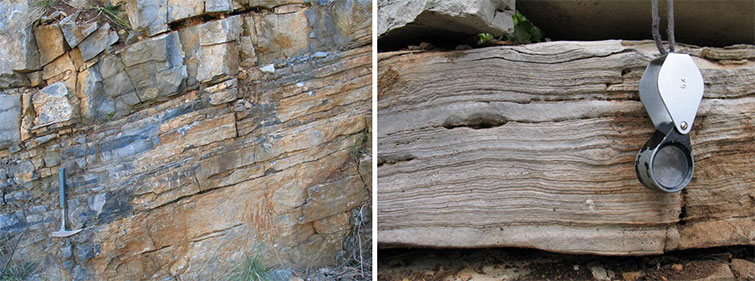
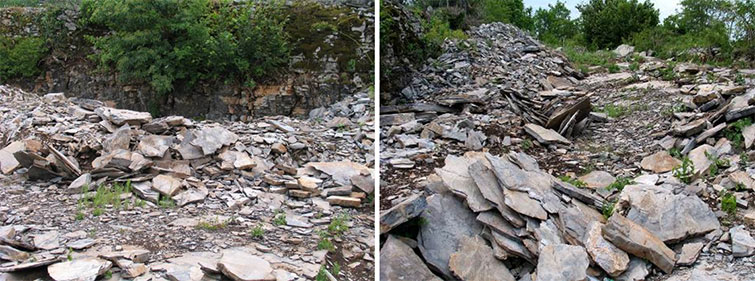
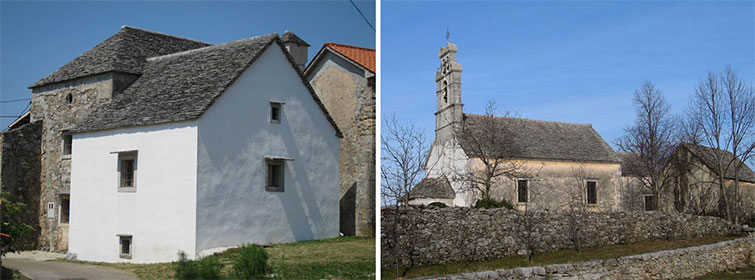
The quality of Komen limestone from the Sežana Fm. and Komen limestone with pelagic microfossils is estimated as medium. The limited quality can be caused by the lamination that commonly appears and may predispose disintegration of the plates into thinner slabs. Due to the relatively thin and spatially dispersed PL horizons we do not propose possible exploitation sites in these PL sequences.
Among all PL types, Tomaj limestone is assessed as having a low potential for further exploitation although in the past it was used as a building material in the south-eastern part of the Kras (e.g. in the surrounding of Dutovlje, Križ, Kazlje) (Fig. 2.24). Lamination commonly reduces the resistance of the plates, while common changes of lithotypes and bed thickness within the PL succession also reduce the potential for use of limestone plates. Abandoned quarries of Tomaj limestone are known only in the vicinity of the Kazlje village.
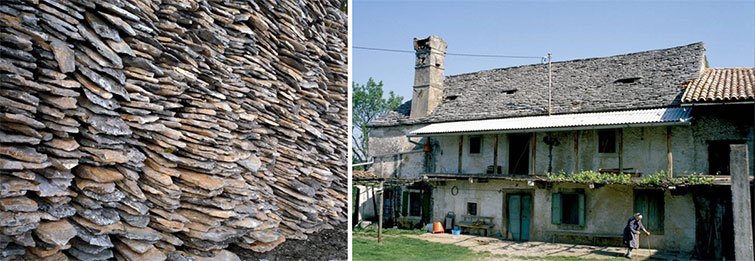
The limestone plates (quasi platy limestone) from fractured Repen and Lipica limestone were recognized as very resistant to climatic conditions and durable on roofs. Fractured Repen limestone was used for roofing in the wider area of Divača, Gorenje (Fig. 2.25) and Povir villages. The plates were excavated from the Repen Fm. which is exposed in a narrow belt between Divača and Sežana. Fractured Lipica limestone was used for roofing in the area of Filipčje Brdo and Križ village. In the past, they were exploited near Filipčje Brdo.
The spatial occurrence of this tectonically related limestone type is very limited. As a possible exploitation locality, the active Griža (Tavčar) quarry near Povir (Fig. 2.25) can be proposed.
The thickness of the fractured limestone plates may present the biggest problem for use as building material, especially for roofing. It highly depends on the distribution of tectonic fractures in nature. Appropriate plates with a uniform thickness along the entire plate are difficult to find since the fractures are not ideally parallel in the outcrops.
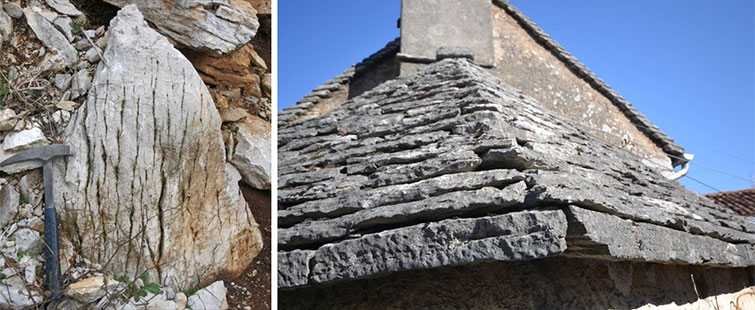
On four samples of PL from the Kras area mechanical analyses of rock strength have been carried out. As can be seen from the correlation between the descriptive geological quality assessment and the analysed values of flexural and compressive strength in the Analysis of platy limestone chemical and mechanical properties (Annex 3.2 and Appendix 2.2), the descriptive expert assessment and numerical values deviate a lot. Deviations were expected since they arise from the lithological characteristics of the platy limestone beds and sequences. Namely, PL successions are not lithologicaly homogeneous as a result of their genesis in a natural environment. The lithology and structure of the rock, and consequently the mechanical characteristics, vary among different beds as well as on the level of individual beds of platy limestone. That is why the analyses gave illogical values of the strength of the samples in some cases. The strength probably reflects the structure of the limestone, i.e. a combination of the grain size, packing, lamination, cement quality in grainy limestones, etc. Very similar discrepancies are noticed in the sclerometer tests (see Annex 3.2).
In terms of usage of limestone for roofing, probably the best way to assess the PL quality (long-term resistance to external climatic conditions) is to carry out an evaluation according to the historical usage durability on existing objects (roofs).
Generally, it can be concluded that the historical use of platy limestone strictly followed the spatial occurrence of the platy limestone in nature. In the northernmost part of the Kras Komen limestone from the Povir Fm. was widely used as building material. It is exposed in the wider area of Komen (Fig. 2.26). In the middle part of the Karst plateau, a limited use of Komen limestone from the Sežana Fm. and Komen limestone with pelagic microfossils was recognized, while in the south-eastern part people used Tomaj limestone for roofing. In the southernmost part of the Kras there are no significant occurrences of genuine platy limestone, therefore, limestone plates from the Repen Formation were used as building material, which is exposed between Divača and Povir (Fig. 2.26).
However, possibilities for further exploitation of platy limestone in the Kras are limited but locations where smaller quantities of limestone plates can be found to be used for the renovation of cultural heritage objects.
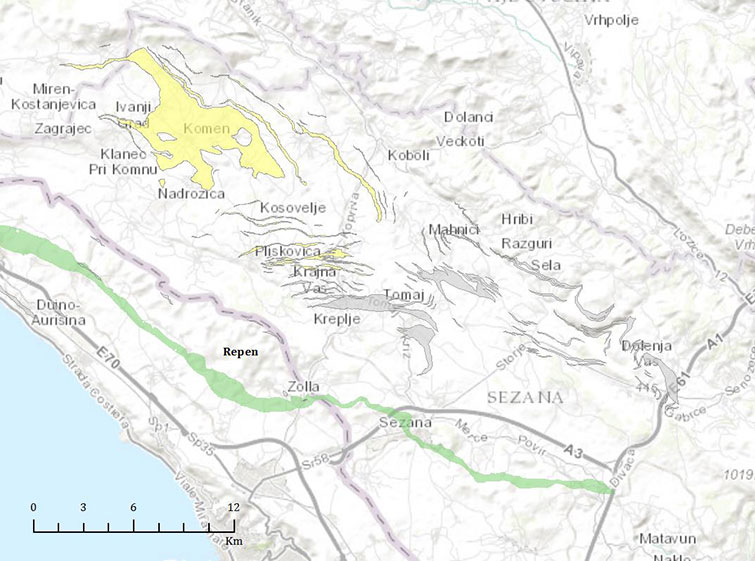
On the basis of the available archive paleontological material, fossil collections and detailed field-work, platy limestone occurrences were evaluated from the aspect of natural heritage.
In the Kras area, platy limestone exposures on the surface can usually be recognized by the flat landscape with vineyards and dry-walls. The most common findings of fishe, reptiles and land plats are known from the Komen limestone in a wider area of Gabrovica and from the Tomaj limestone in the wider area of Tomaj. We propose two locations, Mrtvaški hrib and Zaleškovje, as geo-sites (see Appendix 2.2).










